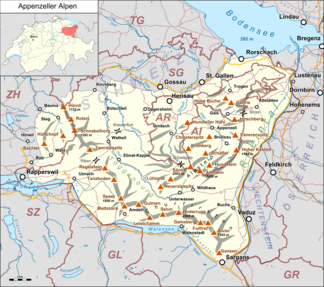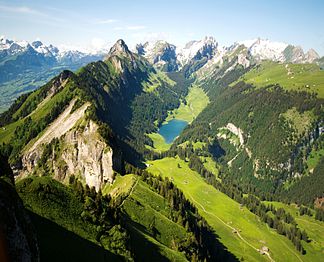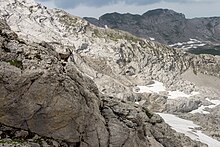Appenzell Alps
| Appenzell Alps | |
|---|---|
|
View from the Hohe Kasten in the Alpstein with the Säntis. |
|
| Highest peak | Säntis ( 2502 m above sea level ) |
| location |
|
| part of | Western alps |
| Coordinates | 744 164 / 234916 |
| surface | 1,800 km² |
The Appenzell Alps are a mountain group of the Western Alps . They are located in Switzerland in the cantons of St. Gallen , Appenzell Innerrhoden and Appenzell Ausserrhoden and cover an area of around 1800 km². They are the north-eastern corner of the Western Alps. The border of the mountain group in the east, the Alpine Rhine Valley , is also the border between the Eastern and Western Alps.
The highest mountain in the Appenzell Alps is the Säntis with a height of 2502 m . The Appenzell Alps consist of several mountain ranges, which are separated by striking valleys. The best known are the Alpstein (with the Säntis) and the Churfirsten .
The mountain group is an Eldorado for hikers and climbers. Several mountain railways lead to the higher regions. The mountains are not high enough for large glaciers; there are only two small glaciers on the Säntis .
The proximity to the Swiss and southern German metropolitan areas means that the Appenzell Alps are often visited. Due to its location on the northern edge of the Alps, the region is fully exposed to the frequent west and north-west weather conditions. As a result, the weather there is often less favorable than in the central and southern parts of the Alps. There is also more frequent rainfall.
Boundary and neighboring mountain groups
Hardly any other mountain group in the Alps is as clearly delimited from the neighboring mountain groups as the Appenzell Alps. Only in the north at the transition into the Alpine foothills towards Lake Constance and the Rhine is a clear border missing.
- In the east the Rhine forms the border to the Bregenzerwaldgebirge and the Rätikon from the confluence with Lake Constance upstream to Sargans . Both are mountain groups in the Eastern Alps. The Bregenz Forest Mountains are located in the Northern , the Rätikon in the Central Eastern Alps . The Rhine is the border between the Western and Eastern Alps.
- The border in the south with the Glarus Alps runs along the Walensee from Sargans over the Sarganser Sattel along the Seez river to the confluence with the Walensee.
- On the west side of the Walensee, the border continues in the southwest to the Schwyz Alps along the Linth Canal to the Obersee (part of Lake Zurich ).
- In the north-west and north there are several variants for drawing the border between the Appenzell Alps and the Appenzellerland and Toggenburg , i.e. the pre-Alps of Switzerland : The border drawn in the guide of the Swiss Alpine Club runs along a line from Uznach over the Rickenpass to Wattwil . From there it goes up the Toggenburg to Nesslau and over the Chräzerenpass at Schwägalp to Urnäsch . From there the border runs directly east to Appenzell and further north past the Fähnerngipfel into the Rhine Valley. Nevertheless, there are still peaks to the north of this border that reach an altitude of 1528 m at the Hochalp . Depending on how you look at it, one or the other northern peaks may still belong to the Appenzell Alps.
Subgroups
The Appenzell Alps are divided into six subgroups:
- Alpstein , southern chain, highest mountain: Roslen or Saxerfirst, 2151 m
- Alpstein , middle chain, highest mountain: Altmann, 2435 m
- Alpstein , northern chain, highest mountain: Säntis, 2501 m
- Speer - Mattstock , highest mountain: Speer , 1950 m
- Churfirsten , highest mountain: Hinterrugg, 2306 m
- Alviergruppe , highest mountain: Gamsberg, 2385 m
The Lisengrat runs from the northern to the middle chain .
summit
The ten highest peaks in the Appenzell Alps:
- Säntis , 2502 m (Alpstein, northern chain)
- Girenspitz (Säntis) , 2448 m (Alpstein, northern chain)
- Altmann , 2435 m (Alpstein, middle chain)
- Gamsberg , 2385 m (Alviergruppe)
- Gross Fulfirst , 2383 m (Alvier group)
- Chalbersäntis , 2376 m (Alpstein, Lisengrat)
- Wildhauser Schafberg , 2373 m (Alpstein, middle chain)
- Chli Fulfirst , 2368 m (Alvier group)
- Wisswand , 2346 m (Alpstein, northern chain)
- Alvier , 2343 m (Alvier group)
Two-thousanders
There are around 100 two-thousanders in the Appenzell Alps. The exact number depends on which towers and secondary peaks are included. The Speer-Mattstock group is the only one of the subgroups that does not have a two-thousand-meter peak.
The relatively large number of two thousand meter peaks is due to the small size of the area with a multitude of steep peaks and towers.
Summit peculiarities
- The Säntis is one of the few mountains from which you can see six countries on a clear day.
- In the Appenzell Alps there are three two-thousand-meter peaks called “Girenspitz” and another called “Gir”.
- The eight Kreuzberge (relatively well-known climbing mountains in the southern Alpstein chain) are numbered. Six of the eight Kreuzberge are two thousand meter peaks.
nature
Lakes
In the south of the Appenzell Alps lies the Walensee at an altitude of 419 m , a fjord-like lake overlooked by the Churfirsten.
There are few lakes in the Appenzell Alps, which is not surprising given the predominant limestone. However, three lakes are characterized by a particularly beautiful and striking location. All three are framed by steep mountain slopes and rock faces. The Seealpsee lies between the middle and the northern chain of the Alpstein at an altitude of 1141 m . The Sämtisersee with a height of 1209 m and the Fälensee with 1452 m are between the southern and the middle chain of the Alpstein. Another lake, the Voralpsee , 1123 m , lies in a valley cut that drains directly to the Rhine valley between the subgroups of the Churfirsten and the Alvier group.
glacier
The Appenzell Alps do not reach the altitude normally required for glaciers to form. Nevertheless, two small glaciers have been preserved in the Alpstein near Säntis. They are called Blau Schnee and Gross Schnee . The blue snow is in the northeast of the Säntis summit, the Gross Schnee in the southeast. Due to the climate changes that can be observed everywhere, the term “glacier” for these snowfields can now be questioned. The reasons for these glaciers at a relatively low altitude are the abundance of precipitation in the Appenzell Alps and the small-scale location of the snow areas in steep, east-facing high cirques. The Rheingletscher reached its greatest extent from this area in the Riss Glaciation and the Würm Glaciation.
Animals
Ibex , chamois , marmots and ptarmigan can be found in the Appenzell Alps .
Protected areas
Landscapes of national importance
In accordance with Article 5 of the Federal Act on Nature Conservation and Heritage Protection, Switzerland keeps a federal inventory of landscapes and natural monuments of national importance .
There are currently two of these landscapes in the Appenzell Alps:
- No. 1612, name: Säntis area , year of inclusion in the inventory: 1996, size: 17,939 ha
- No. 1613, name: Speer-Churfirsten-Alvier , year of inclusion in the inventory: 1996, size: 30,294 ha
tourism
The area of the Appenzell Alps offers a wide range of tourist opportunities in summer and winter. The region offers a wide network of hiking trails, ranging from the plains to mountain hikes. Skiing is the main activity in winter.
Long-distance / long-distance hiking trails
- The Via Alpina , a cross-border long-distance hiking trail with five partial trails through the entire Alps, runs along the edge of the Appenzell Alps: Stage C2 runs from Vaduz to Sargans via Sevelen , Gretschins , Fontnas, Azmoos and Vild .
- The Thurweg , a long-distance hiking trail of the «St. Gallen hiking trails », leads from Wil SG via Wattwil to Wildhaus in Toggenburg. At Wattwil the path enters the mountain range of the Appenzell Alps. The entire long-distance hiking trail is 60 km away and takes around 17 hours to walk. Approx. 32 km or approx. 9.5 hours of this run in the Appenzell Alps.
- The Rheintal-Höhenweg , also from the «St. Gallen hiking trails »created, leads from Rorschach to Sargans via Altstätten and Wildhaus. From the village of Eichberg south of Altstätten, the long-distance hiking trail runs in or on the edge of the Appenzell Alps. The entire path is 115 km long and takes about 32 hours to walk. 79 km or approx. 22 hours of this run in the Appenzell Alps.
Winter tourism
Winter tourism is also important in the Appenzell Alps. The largest winter sports region is the upper Toggenburg with the places Wildhaus , Unterwasser and Alt St. Johann and the peaks Gamserrugg and Chäserrugg in the Churfirsten with a length of more than 60 kilometers of slopes. Amden and Krummenau -Wolzenalp in the Speer-Mattstock area are smaller areas. The 2502 m high Säntis also offers the possibility of alpine runs. In the canton of Appenzell Innerrhoden there is also the ski area on the Ebenalp and other lifts. The Appenzell Alps are also extremely popular for ski tours. The small, otherwise touristically rather insignificant town of Stein SG, as a starting point on sunny winter days, becomes a Mecca for tourers. Even cross-country skiing and winter hiking are very popular.
Web links
- Boundary of the Appenzell and Toggenburg Alps on GeoFinder.ch
- Appenzell Alps on DeineBerge.de
Individual evidence
- ↑ Ernst Höhne: Knaurs Lexikon für Bergfreunde / The Alps between Matterhorn and Lake Constance . Droemer Knaur, Munich 1987, ISBN 3-426-26223-1 , p. 29 ff .
- ^ Lisengrat in the SwitzerlandMobility map
- ↑ Chalbersäntis in SwitzerlandMobility map






